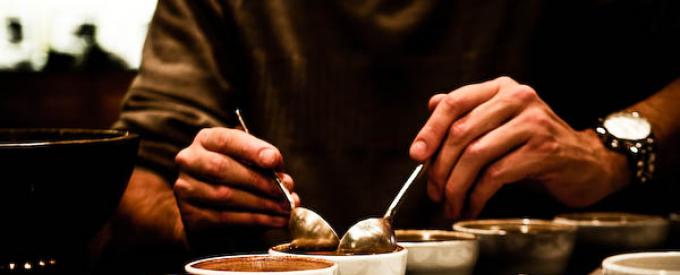Tasting Terms

While tasting and comparing a fresh cup of coffee, try to discern whether the flavor, body, acidity and aroma of the coffee is pleasant, or unpleasant. Here are the criteria that most tasters use to judge coffee:
Acidity
Acidity is a desirable characteristic in coffee. It is the sensation of dryness that the coffee produces under the edges of your tongue and on the back of your palate. The role acidity plays in coffee is not unlike its role as related to the flavor of wine. It provides a sharp, bright, vibrant quality. Without sufficient acidity, the coffee will tend to taste flat. Acidity should not be confused with sour, which is an unpleasant, negative flavor characteristic.
Aroma
Aroma is a sensation which is difficult to separate from flavor. Without our sense of smell, our only taste sensations would be: sweet, sour, salty, and bitter. The aroma contributes to the flavors we discern on our palates. Subtle nuances, such as "floral" or "winy" characteristics, are derived from the aroma of the brewed coffee.
Body
Body is the feeling that the coffee has in your mouth. It is the viscosity, heaviness, thickness, or richness that is perceived on the tongue. A good example of body would be that of the feeling of whole milk in your mouth, as compared to water. Your perception of the body of a coffee is related to the oils and solids extracted during brewing. Typically, Indonesian coffees will possess greater body than South and Central American coffees. If you are unsure of the level of body when comparing several coffees, try adding an equal amount of milk to each. Coffees with a heavier body will maintain more of their flavor when diluted.
Flavor
Flavor is the overall perception of the coffee in your mouth. Acidity, aroma, and body are all components of flavor. It is the balance and homogenization of these senses that create your overall perception of flavor. The following are typical flavor characteristics:
General Flavor Characteristics
- Richness-refers to body and fullness
- Complexity- the perception of multiple flavors
- Balance- the satisfying presence of all the basic taste characteristics where no one over-powers another Typical specific desirable flavor characteristics
- Bright, Dry, Sharp, or Snappy- (typical of Central American coffees)
- Caramelly -candy like or syrupy
- Chocolaty- an aftertaste similar to unsweetened chocolate or vanilla
- Delicate- a subtle flavor perceived on the tip of the tongue (typical of washed New Guinea rabica)
- Earthy- a soily characteristic (typical of Sumatran coffees)
- Fragrant- an aromatic characteristic ranging from floral to spicy
- Fruity- an aromatic characteristic reminiscent of berries or citrus
- Mellow- a round, smooth taste, typically lacking acid
- Nutty- an aftertaste similar to roasted nuts
- Spicy- a flavor and aroma reminiscent of spices
- Sweet- free of harshness
- Wildness- a gamey flavor which is not usually considered favorable but is typical of Ethiopian coffees
- Winy- an aftertaste reminiscent of well-matured wine (typical of Kenyan and Yemeni coffees)
Typical specific undesirable flavor characteristics
- Bitter- perceived on the back of the tongue, usually a result of over roasting
- Bland- neutral in flavor
- Carbony- burnt charcoaly overtones
- Dead- see "flat"
- Dirty- a mustiness reminiscent of eating dirt
- Earthy- see "dirty"
- Flat- lack of acidity, aroma, and aftertaste
- Grassy- an aroma and flavor reminiscent of freshly cut lawn
- Harsh- a caustic, clawing, raspy characteristic
- Muddy- thick and dull
- Musty- a slight stuffy or moldy smell (not always a negative characteristic when in aged coffees)
- Rioy- a starchy texture similar to water which pasta has been cooked in.
- Rough- a sensation on the tongue reminiscent of eating salt
- Rubbery- an aroma and flavor reminiscent of burnt rubber (typically found only in dry-processed robustas)
- Soft- see "bland"
- Sour- tart flavors reminiscent of unripe fruit
- Thin- lacking acidity, typically a result of under brewing
- Turpeny- turpentine-like in flavor
- Watery- a lack of body or viscosity in the mouth
- Wild- gamey characteristics
